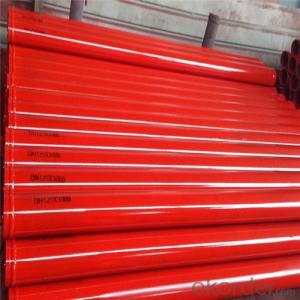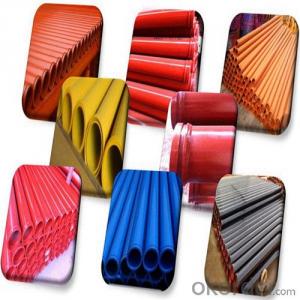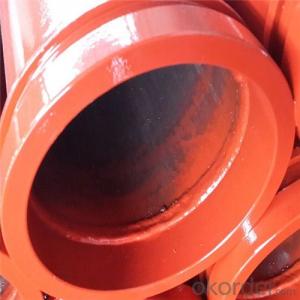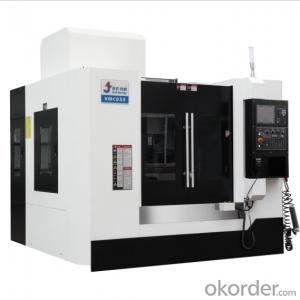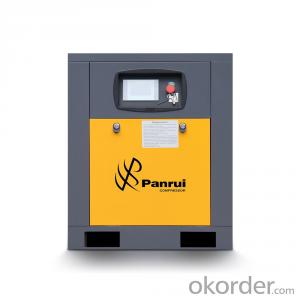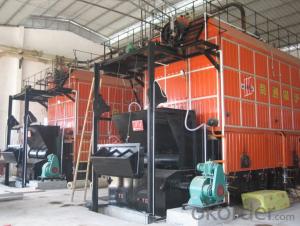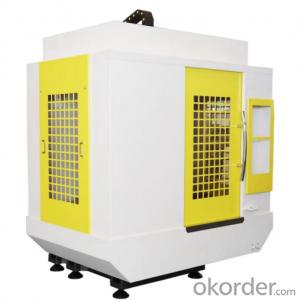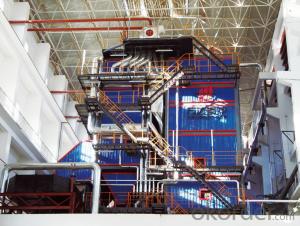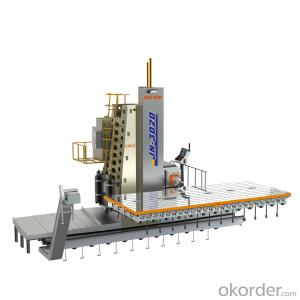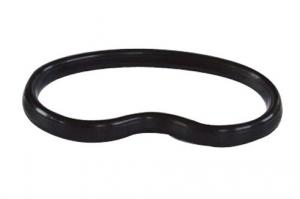3M Concrete Pump St52 Weld Delivery Pipe
- Loading Port:
- Tianjin
- Payment Terms:
- TT or LC
- Min Order Qty:
- 50 pc
- Supply Capability:
- 5000 pc/month
OKorder Service Pledge
OKorder Financial Service
You Might Also Like
3M Concrete Pump St52 Weld Delivery Pipe
1. Structure of 3M Concrete Pump St52 Weld Delivery Pipe:
St52 Weld Pipe: Main use for Trailer-mounted pump, thickness has 4.0mm, 4.5mm, 5mm. Compare with for Truck-mounted pump. Weld pipe has cheaper price, so it is popular in Saudi, Pakistan, India, etc. Unit Price is about 30USD-33USD.
St52 Seamless Pipe: Now More People like use this kind for Truck Pump and Trailer Pump because of the quality is better and it is seamless kind, so this kind pipe is most popular in Middle East Price About 34USD-37USD.
Wear Resistant Pipe: Use for Truck Pump, Wear Resistant Layer is 2.5mm.Through heat treatment way make this pipe more strong (HRC60-62), Using Life: 25,000m³-35,000m³ Price about 65USD-68USD.
Two Wall Pipe: This pipe thickness (2mm+2.5mm), Using Life about 50,000m³-60,000m³
2. Main Features of 3M Concrete Pump St52 Weld Delivery Pipe:
• High Wear-resistant, long service life, lower cost
• In case of quality problem the company provide free replacement.
• Provide technical support for free.
• Provide consumers with regular visits
• Ensure the supply of ancillary parts
• Our company passed the ISO9000 certification, the product through 3C certification in full compliance with national standards
3. 3M Concrete Pump St52 Weld Delivery Pipe Images
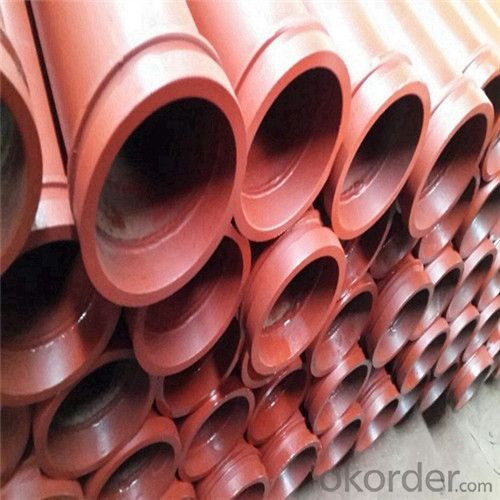
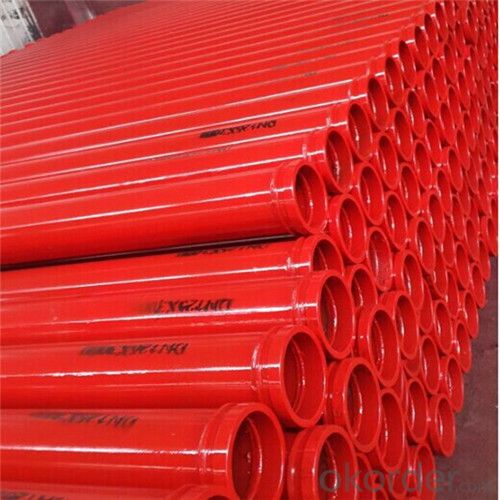

4. 3M Concrete Pump St52 Weld Delivery Pipe Specification
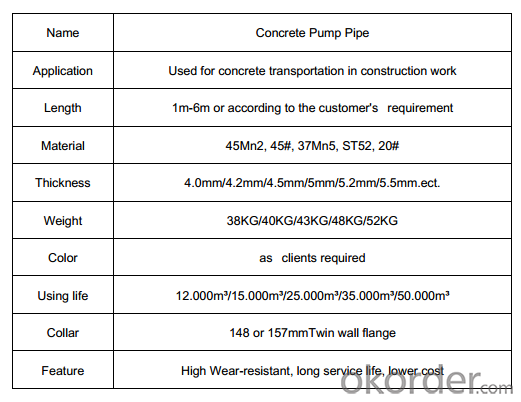
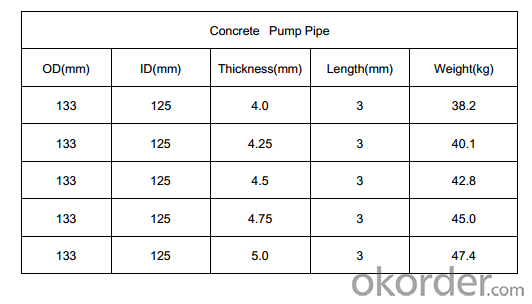
Production Process
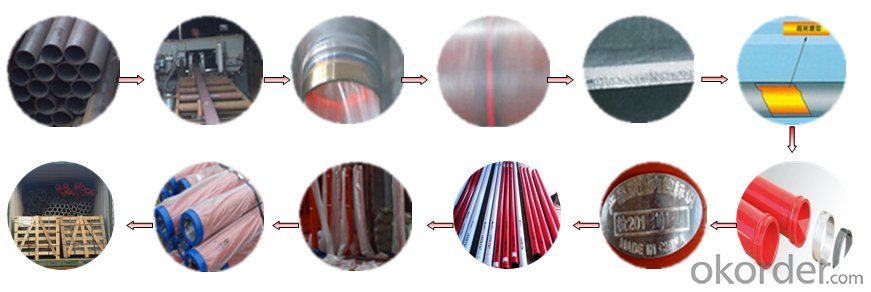
5. FAQ
We have organized several common questions for our clients, may help you sincerely:
①Is your products exported a lot?
We have exported to many, many countries. Every year we ship more than 30 containers of these spare parts. Our main market is in Middle-east, Asia & Africa.
②How to guarantee the quality of the products?
We have established the international advanced quality management system,every link from raw material to final product we have strict quality test;We resolutely put an end to unqualified products flowing into the market. At the same time, we will provide necessary follow-up service assurance.
③How long can we receive the product after purchase?
In the purchase of product within three working days, we will arrange the factory delivery as soon as possible. The specific time of receiving is related to the state and position of customers. Commonly 15 working days can be served.
6. Why choose us
• We are a comprehensive manufacturing and trading company.
• Our company is one of the biggest manufacturing and trading companies in China.
• We have been specialized in producing concrete pump spare parts and specialized in producing all kinds of concrete pump parts. As Concrete Pump Pipe, Concrete Pump Elbow, Concrete Pump Rubber Hose, Concrete Pump Wear Plate, Concrete Pump S Valve, Concrete Pump Piston and so on.
• We are famous for our superior quality, competitive prices, first-class craftworks, safe package and prompt delivery.
• We have been supplying concrete pump parts for SCHWING, PUTZMEISTER, SANY, CIFA, KYOKUTO, ZOOMLION for 10 years, so we can promise you the quality and best price.
- Q:What is the role of a concrete pump hopper agitator shaft?
- The role of a concrete pump hopper agitator shaft is to ensure the consistent and uniform mixing of concrete within the hopper. It rotates to prevent the concrete from settling or becoming compacted, ensuring a smooth and continuous flow of concrete through the pump, ultimately improving the efficiency and effectiveness of the pumping process.
- Q:What are the common signs of wear and tear in a concrete pump cylinder?
- Some common indications that a concrete pump cylinder is experiencing wear and tear include: 1. Leakage of oil or hydraulic fluid: The presence of oil or hydraulic fluid leaking from the cylinder is a clear indication that it has sustained damage or wear. This could be a result of cracks, worn seals, or damaged gaskets. 2. Decreased pumping efficiency: A worn cylinder may lead to a reduction in pumping efficiency, resulting in the concrete pump's inability to deliver the same amount of concrete as before. This decline could be due to a decrease in the cylinder's internal diameter or worn piston rings. 3. Heightened noise and vibration: As the cylinder deteriorates, it may produce more noise and vibration during operation. This can suggest issues like misalignment, loose components, or damaged internal parts. 4. Uneven or rough concrete output: A worn cylinder can cause the concrete output to be uneven or rough. This issue may arise from an irregular internal surface or damaged piston rings, which disrupt the smooth movement of the piston. 5. Excessive generation of heat: A worn concrete pump cylinder may generate additional heat while in operation. This can be attributed to increased friction between moving parts, which can further contribute to accelerated wear and tear. 6. Visible damage or corrosion: By inspecting the cylinder's surface, visible signs of wear and tear such as scratches, dents, or corrosion can be identified. These damages can compromise the cylinder's integrity and may necessitate repair or replacement. It is crucial to regularly inspect the concrete pump cylinder and promptly address any signs of wear and tear to prevent further damage and maintain the pump's optimal performance.
- Q:How can one store and handle concrete pump spare parts to maintain their quality?
- To maintain the quality of concrete pump spare parts, it is crucial to store and handle them properly. Firstly, these spare parts should be stored in a clean and dry environment, away from moisture and direct sunlight. They should also be protected from dust and debris by using suitable covers or packaging. Additionally, it is important to handle them with care, avoiding any rough or improper handling that could cause damage. Regular inspection and maintenance of the spare parts should also be conducted to identify any signs of wear or corrosion, ensuring they are in optimal condition when needed for use.
- Q:Are there any specific guidelines for the installation of sensors or transmitters in concrete pump spare parts?
- Concrete pump spare parts have specific guidelines for the installation of sensors or transmitters. These guidelines are crucial to guarantee the sensors or transmitters function properly and provide accurate readings. To start, it is vital to carefully select an appropriate location for sensor or transmitter installation. The chosen location should allow for easy access and maintenance, while also protecting the sensors or transmitters from excessive vibration, moisture, or extreme temperatures. Furthermore, it is advisable to use suitable mounting hardware to secure the sensors or transmitters to the concrete pump spare parts. This hardware should be capable of withstanding operating conditions and any vibrations or shocks that may occur during the pumping process. Additionally, following the manufacturer's instructions for wiring and connection of the sensors or transmitters is essential. Proper wiring and connection ensure accurate and reliable data transmission. Moreover, regular inspections and maintenance are necessary to ensure the sensors or transmitters function correctly. This involves checking for loose connections, signs of wear or damage, and ensuring proper calibration. Overall, adhering to these specific guidelines for sensor or transmitter installation in concrete pump spare parts can enhance performance and durability, ultimately improving the efficiency and safety of concrete pumping operations.
- Q:How often should hopper cylinder seals be replaced in a concrete pump?
- The replacement frequency of hopper cylinder seals in a concrete pump varies depending on factors such as seal quality, usage intensity, and maintenance practices. It is recommended to regularly inspect hopper cylinder seals for any signs of wear or damage, and if cracks, tears, or leaks are visible, immediate replacement is advised to prevent further damage to the concrete pump. In general, hopper cylinder seals can last for several months to a couple of years, depending on the aforementioned factors. However, it is crucial to establish a preventive maintenance plan and regularly monitor the seals' condition to ensure optimal performance and minimize downtime. Furthermore, consulting the manufacturer's guidelines or seeking advice from a professional concrete pump technician is advisable to determine the specific replacement interval for hopper cylinder seals based on the pump model, usage patterns, and environmental conditions.
- Q:How does a hydraulic oil cooler maintain optimal temperature in a concrete pump?
- A hydraulic oil cooler plays a crucial role in maintaining optimal temperature in a concrete pump by effectively dissipating heat generated during the hydraulic system's operation. As the hydraulic system of a concrete pump is continuously subjected to high pressure and heavy loads, the oil within the system tends to heat up rapidly. If the oil temperature exceeds the recommended range, it can lead to a decrease in overall system efficiency, increased wear and tear of components, and potential system failure. To prevent these issues, a hydraulic oil cooler is installed in the concrete pump. It works by utilizing a heat exchanger that transfers the excessive heat from the hydraulic oil to the surrounding air or another cooling medium, such as water or a refrigerant. This heat exchange process helps to lower the temperature of the hydraulic oil, maintaining it within the optimal operating range. The hydraulic oil cooler typically consists of a series of fins or tubes through which the hot oil flows. These fins or tubes increase the surface area of contact between the oil and the cooling medium, allowing for efficient heat transfer. Additionally, a fan or a pump may be used to enhance the airflow or flow of the cooling medium, further improving the cooling process. By maintaining the hydraulic oil at an optimal temperature, the hydraulic oil cooler ensures that the concrete pump operates at its peak performance. This not only increases the overall efficiency and productivity of the pump but also prolongs the lifespan of critical components. Moreover, by preventing overheating, the hydraulic oil cooler helps to minimize the risk of costly and unexpected downtime due to system failure. In conclusion, a hydraulic oil cooler is an essential component in a concrete pump that maintains optimal temperature by dissipating excessive heat from the hydraulic oil. By effectively cooling the oil, it ensures the smooth operation, efficiency, and longevity of the hydraulic system, ultimately contributing to the overall productivity and reliability of the concrete pump.
- Q:How can one determine the correct pressure and flow rating for hydraulic components in concrete pump spare parts?
- When determining the correct pressure and flow rating for hydraulic components in concrete pump spare parts, several factors should be taken into account: 1. Review the manufacturer's specifications for the hydraulic components. These specifications should provide the recommended pressure and flow ratings for optimal performance and durability. 2. Assess the concrete pump system's specific requirements. Factors such as pump size, concrete volume and distance, and required delivery speed should be considered. These factors will help determine the necessary pressure and flow rating for the hydraulic components. 3. Ensure that the pressure and flow rating of the hydraulic components fall within the safe operating limits of the concrete pump system. Going beyond these limits can result in equipment failure, accidents, or component damage. 4. Verify the compatibility of the hydraulic components with the rest of the system. The pressure and flow rating should align with the capabilities and specifications of other components like the pump, valves, and hoses to guarantee proper functionality and performance. 5. If unsure about the appropriate pressure and flow rating, seek guidance from hydraulic system experts or the manufacturer's technical support team. They can offer advice based on their expertise and experience with similar systems. It's important to note that the pressure and flow rating of hydraulic components may vary depending on the specific model, design, and intended application. Therefore, referring to the manufacturer's guidelines and recommendations is crucial to accurately determine the correct pressure and flow rating for hydraulic components in concrete pump spare parts.
- Q:What is the difference between concrete pump and ground pump?
- The pump is easy to move and flexible, but generally limited to the length of the boom by 60-70m. The ground pump is not limited by height, but it needs to be connected with the conveying pipe, which is of poor flexibility
- Q:How does a concrete pump clamp work?
- A concrete pump clamp is a device used to secure and hold the different components of a concrete pump system together during operation. It acts as a connector between the pipes, hoses, and couplings in the system, ensuring a tight and leak-free connection. The clamp generally consists of two halves that are tightened together using bolts, creating a strong grip around the components. This tight grip prevents any movement or separation of the pipes and hoses, allowing for efficient and safe concrete pumping.
- Q:Are there any specific guidelines for the disposal of hydraulic fluids used in concrete pump spare parts?
- Concrete pump spare parts require specific guidelines for disposing of the hydraulic fluids they use. Hydraulic fluids contain chemicals and contaminants that can harm the environment if not disposed of correctly. Here are some general guidelines to follow: 1. Research local regulations: Different regions have specific laws and regulations for disposing of hydraulic fluids. It's important to familiarize yourself with these rules to make sure you comply. 2. Prevent leaks: Properly contain the hydraulic fluid to avoid leaks or spills during transportation. Use containers designed for hazardous materials. 3. Avoid mixing fluids: Don't mix hydraulic fluids with other substances as it can complicate disposal and increase environmental damage. 4. Find a licensed disposal facility: Locate a licensed facility that handles hazardous waste disposal. These facilities have the equipment and expertise to handle hydraulic fluids safely. 5. Follow instructions: When delivering the hydraulic fluid to the disposal facility, follow their specific drop-off instructions. They may require specific labeling or documentation for proper handling. 6. Consider recycling options: Depending on the type of hydraulic fluid, recycling might be an option. Some facilities specialize in recycling hydraulic fluids, which is more environmentally friendly. 7. Educate staff: Make sure all personnel working with hydraulic fluids understand proper disposal procedures and their importance. By following these guidelines, you can safely and responsibly dispose of hydraulic fluids used in concrete pump spare parts, minimizing environmental harm and complying with regulations.
1. Manufacturer Overview |
|
|---|---|
| Location | |
| Year Established | |
| Annual Output Value | |
| Main Markets | |
| Company Certifications | |
2. Manufacturer Certificates |
|
|---|---|
| a) Certification Name | |
| Range | |
| Reference | |
| Validity Period | |
3. Manufacturer Capability |
|
|---|---|
| a)Trade Capacity | |
| Nearest Port | |
| Export Percentage | |
| No.of Employees in Trade Department | |
| Language Spoken: | |
| b)Factory Information | |
| Factory Size: | |
| No. of Production Lines | |
| Contract Manufacturing | |
| Product Price Range | |
Send your message to us
3M Concrete Pump St52 Weld Delivery Pipe
- Loading Port:
- Tianjin
- Payment Terms:
- TT or LC
- Min Order Qty:
- 50 pc
- Supply Capability:
- 5000 pc/month
OKorder Service Pledge
OKorder Financial Service
Similar products
New products
Hot products
Related keywords
